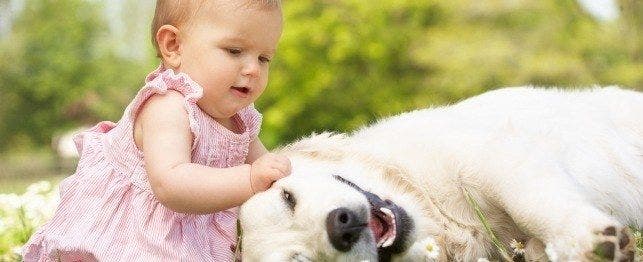
Preparing Your Dog for a New Baby
Preparing Your Dog for a New Baby
Prepping your dog for the arrival of new baby is crucial for a peaceful home. Bringing home a baby is a huge adjustment for both people and our dogs. If your dog has spent limited time with a baby or children, or your dog has been your only “child” for some time, many of the adjustments may be upsetting.
Take action now to avoid additional stress and make this time of transition as smooth as possible for you, your baby and your dog.
Tips to Help Your Dog Adjust to the New Baby
Here are some tips to help your dog and new baby get along:
- Do not try to love/snuggle/play with your dogs as much as possible right now! While it may sadden you to think your time with your dogs will soon be shared, or significantly reduced, showering them with extra attention now sets them up for an even bigger letdown when the baby arrives.
- If you have neglected to teach your dog any commands, it is time to buckle down and get serious with the training. It will be very useful to have a dog that can obey the bare minimum commands of sit and stay, along with knowing not to jump up on people. Dogs can be dangerous underfoot when carrying a little one, so teaching your dog a command to get back can also be a good idea.
- If you currently sleep with your dogs and plan on having your baby sleep in your room for any length of time, kick your dogs out in advance. You can’t supervise while you are asleep. If you choose to keep your dog in the room at night, make sure your bassinet is secure and locked in place and that your dog cannot get into it.
- Review the steps to avoid bites between dogs and children pronto and learn how to recognize signs of canine stress.
- Change up their routine. If your dogs are on a schedule, it’s time to break out of it. If they are used to being fed at 7 am followed by a brisk walk, try altering that time and order. Babies bring chaos; acclimate your dogs now to reduce stress.
- If you don’t use your dog crate regularly, start doing so now. Just because your dog is able to wander free and guard the house unsupervised now does not guarantee he won’t rebel when baby arrives and diverts attention. Avoid the additional stress of destroyed objects and introduce the crate in small increments. While this may seem unnecessary, skipping this step risks that. The crate will also be a safe haven for the dog once baby arrives.
- Introduce your dogs to baby objects, sounds, and smells. Some easy ways to do this are simply setting up the nursery and having baby objects out in the home. Play a YouTube video of babies crying for your dogs with regularity or consider playing a CD of baby lullabies if you will be using one. Some people find it useful to carry a doll around and initiate the rules you will enforce when your real baby arrives. You can even have someone bring home a blanket your baby was swaddled in at the hospital before you are discharged so your dogs can acclimate to the smell.
- Arrange for help so your dogs won’t be neglected. You will want at least a couple of people lined up to care for your dogs when you go into labor, as you may not be able to get in touch with everyone. Once home, see if you can arrange for a friend to take your dog for a daily walk and some play time. Look into doggie daycare as another option.
- Don’t wait until month nine (or right before the estimated arrival of your adopted little one) to make these changes. Due dates and adoption dates are only estimates and constantly changing. The more time you spend prepping your dogs for baby’s arrival now, the less time you will have to spend troubleshooting problems after your little one arrives.
- Sadly, many parents give up their fur children after the arrival of human ones because of behavior problems that could have been largely avoided.
I hope these tips help your dog and home adjust to your new baby.